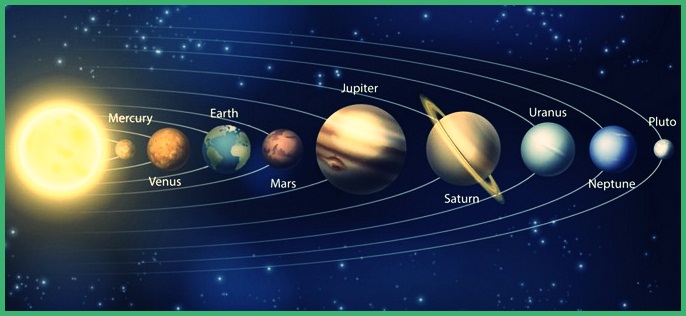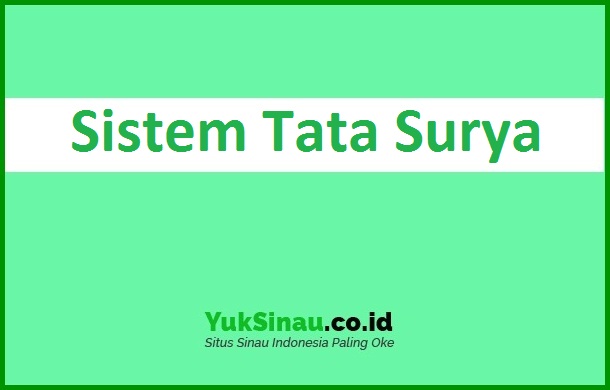Solar System
The solar system is defined as a system consisting of various celestial bodies such as the sun, planet-planet, comet, asteroids and other small celestial bodies. For more details, see our discussion of the Material of the Solar System, Definition, Member, Order, Planet Name and Image.
Table of Contents
Understanding the Solar System

The solar system is defined as a system consisting of various celestial bodies such as the sun, planet-planet, comet, asteroids and other small celestial bodies.
From some of these celestial bodies, The sun is the center of orbit in the solar system, as one astronomer has pointed out, mathematician, named Copernicus in 1543.
Copernicus explained the sun-centered model of the solar system (heliocentric), that the sun is the center of an orbit where the other members of the solar system revolve around the sun.
This model basically replaces a theory that was popularized by a Greek scientist, Ptolemy.
He proposed a theory geocentric, namely that the earth is the center of the solar system, and other objects around the earth.
The distance between the sun and the center of the galaxy is estimated 27.700 light years. Then what is a galaxy?
Galaxies are massive systems that have something to do with the gravitational force that consists of stars, interstellar medium gas and dust, as well as dark matter.
Members of the Solar System
When observed from space, then the earth will look like a small ball moving around the star which in this case is the sun.
Apart from earth, there are other planets that move around the sun. But it's not just the planets that orbit the sun, because there are also other celestial bodies that do this.
The celestial bodies are asteroids, meteor, natural satellite, & comet.
All of these astronomical objects are arranged into a unit and have formed a very orderly system.
So that the planets between the planets do not experience collisions. Such a perfect system is thus referred to as the solar system.
The following is an explanation of the astronomical objects that are members of the solar system :
1. Stars in the Solar System
Stars are members of the solar system which have special properties because they are able to emit their own light.
In the solar system, so many stars that can not be counted.
However, one of the many stars is the sun. which the Sun is a type of star that is very beneficial for life on earth.
Where the sun is very useful because it is a source of light and also a source of heat that can be utilized by living things.
In addition, the sun has the greatest mass when compared to other stars in the solar system.
Because of the mass that the sun has, the sun's gravitational force can make the planets and other celestial bodies revolve in certain trajectories.
2. Planet-planet
Planets are one of the celestial bodies that cannot emit their own light, but only reflects sunlight.
According to International Astronomical Audit (IAU), A planet is a celestial body that has an orbit around the sun.
The planets in the solar system also have enough mass and gravity to form spherical structures, that jam, have a clean orbit. The planets in the solar system are: :
| No. | Planet | Revolutionary Period | Rotation Period |
| 1. | Mercury | During 88 day | 59 day |
| 2. | Venus | During 225 day | 243 day |
| 3. | Earth | Hi 365 day | 24 jam |
| 4. | Mars | Hi 687 day | 24,6 jam |
| 5. | Jupiter | During 11,86 year | 10 jam |
| 6. | Saturn | During 29,5 year | 10,7 jam |
| 7. | Uranus | During 84 year | 17 jam |
| 8. | Neptune | During 165 year | 16 jam |
We have sorted the names of the planets based on their distance from the sun, starting from the closest to the farthest from the sun.
3. Satellites in the Solar System
Satellites are members of the solar system where these satellites always circle the planet.
In which all of these satellites will move around the sun along with the planets they rotate or become their rotation.
other than that, the satellite will rotate on its axis and circle the planet it accompanies or orbits the planet.
The satellites in the solar system are divided into: 2 types based on their existence, namely natural satellites and artificial satellites. The explanation of the 2 types of satellites is as follows :
a. Natural Satellite
Natural satellite is a space object where this object is not man-made that orbits a planet or other object that is larger in size.
All the planets in the solar system have natural satellites. Except for the planet Venus & Mercury. The following lists the names of the natural satellites of every planet in the solar system.
| No. | Planet | Satellite Name | Total Satellite |
| 1. | Mercury | – | |
| 2. | Venus | – | |
| 3. | Earth | Month | 1 |
| 4. | Mars | Phobos and Demos | 2 |
| 5. | Jupiter | Metis, Caliste, Leda, Himalaya, Lysithea, Elara, Andraste, Almathea, Shield, Io, Europa, Carmen, Pasiphea, Synopsis, Ganymede,Ananke, and 3 no name yet. | 16 |
| 6. | Saturn | Tethys, Telesto, Dione coorbital, Rhea, Titan, Euphemetheus, Janus, mimes, 1980 S5, Encelandus, Hyperion, Lapetus, 1980 S6 Coorbital, Atlas, 1980 S27, 1980 S26, Calypso, Dione, Phoebe. | 21 |
| 7. | Uranus | Miranda, Cordelia, Ophelia, Puck, Bianca, grow, Demon, Juliet, Portia, Ariel, umbria, Titania, Oberon, Rosalin, Belinda. | 15 |
| 8. | Neptune | Thalassa, Despina, Naiad, Galatea, Larissa, Proteus, Triton, Nereid | 8 |
b. Artificial Satellites
Artificial satellites are satellites that have been successfully created by humans in which all of the satellite's movements have been regulated by humans.
So that it is able to move in the solar system according to the purpose of its manufacture.
This artificial satellite was deliberately created and designed with the aim of researching and observing celestial objects located in space.
One of the human-made satellites is the Palapa satellite which is Indonesia's domestic communications satellite.
The following is an explanation of some types of artificial satellites complete with their functions :
| Satellite Name | Functions and Examples |
| Communications satellite | Its function is to become a transmitting station placed in space. An example is Echostar 3 |
| Weather satellite | Serves to monitor the weather on the surface of the earth. An example is the TIROS satellite. |
| Imaging satellite (SDA) | Used to map the earth's surface. An example is LANDSAT |
| Satelit global positioning System | To determine the longitude position, and latitude, as well as the altitude of a place, System which is similar to GPS among others GLONASS |
| Research satellite | An example is the SOHO satellite launched to study the sun |
4. Asteroids in the Solar System
Asteroids are astronomical bodies in the form of small fragments that circulate on a trajectory between the orbits of Mars and Jupiter.
The process of forming asteroids occurs simultaneously with the process of forming planets according to the order
Later in the year 1801 a scientist from italy conducted research on asteroids in the solar system for the first time.
The scientist's name is Guiseppa Piazzi and the asteroid that has been studied is named Ceres.
5. Comet (Comet Star)
Comets are celestial bodies that have small sizes. The material or components that make up comets consist of a number of rock particles, kristal, es, & gas.
Comets will usually look like a celestial body that has light and has an elongated shape resembling a tail.
Because of this, people often refer to it as a tailed star. Comet itself consists of 3 part is the main part, come, & tail.
other than that, Comet nuclei are made of ice crystals & a frozen gas that has a diameter of approx 10 km.
Comet coma itself has a diameter that can reach a length 100.000 km, which is much larger than the nucleus.
6. Meteors or Meteoroids
Meteors are celestial bodies that can move fast and have irregular trajectories.
Surely you have heard the term shooting star, not?, it is actually a meteor that can be seen by humans.
The phenomenon that actually occurs is that when someone sees a shooting star, it is actually a meteor that moves freely in this solar system because it is attracted by the Earth's gravitational force..
When the meteor moves freely and falls towards the surface of the earth, then the meteor rubs against the earth's atmosphere and emits light.
The cause of the friction, the temperature of the meteor rises which then burns until it finally evaporates.
The Sun As The Center Of The Solar System
As discussed above, that the sun is a star in the solar system and has a very heavy mass i.e 300.000 times the mass of the earth.
However, the sun is not the biggest star when compared to 100 billion more stars in the Milky Way galaxy.
the following are elements, ingredient name, along with the mass in the sun which we will present in tabular form :
| Element Name | Material Name | Mass in the Sun (%) |
| Hydrogen | H | 76,94 |
| Helium | He | 21,80 |
| Oxygen | THE | 0,80 |
| Carbon | C | 0,40 |
| Neon | Yes | 2,00 |
| Iron | Fe | 0,10 |
| Nitrogen | N | 0,10 |
| Silicone | And | 0,10 |
| Magnesium | Mg | 0,08 |
| Sulfur | S | 0,05 |
| Nickel | In | 0,01 |
Order of the planets closest to the sun
The following are the planets that are closest to the sun and we have sorted them according to their distance from the sun, starting from the closest to the farthest from the sun..
| No | Nama Planet | Distance from the Sun |
| 1 | Mercury | 35,98 million miles |
| 2 | Venus | 67,24 million miles |
| 3 | Earth | 92,96 million miles |
| 4 | Mars | 141,6 million miles |
| 5 | Jupiter | 483,8 million miles |
| 6 | Saturn | 890,8 million miles |
| 7 | Uranus | 1,784 billion miles |
| 8 | Neptune | 2,793 billion miles |
The solar system is defined as a system consisting of various celestial bodies such as the sun, planet-planet, comet, asteroids and other small celestial bodies.
Members of the solar system are celestial bodies such as stars, planet, meteor, meteroid satelit, comet, asteroid .
As for, The composition of the celestial bodies consists of the sun, planets revolving around the sun, comet, and asteroids, and also other celestial bodies called the solar system.
1. Star,
2. Planet,
3. Meteor,
4. Meteroid
5. Satellite,
6. Comet,
7. Asteroid .
Thus our explanation of the Material of the Solar System and its Explanations. Don't forget to always visit our website so that you can get a lot of knowledge. Thank you.
Other Articles :
- Southeast Asia Map
- Indonesian map
- World map
The post Sistem Tata Surya appeared first on YukSinau.co.id.
